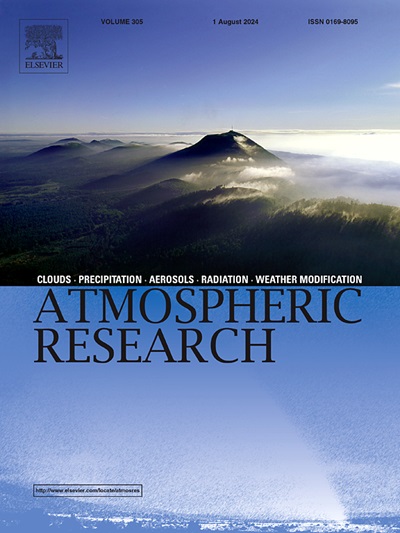麦登-朱利安涛动对明打威群岛日降水动力学的影响:高分辨率卫星视角
IF 4.5
2区 地球科学
Q1 METEOROLOGY & ATMOSPHERIC SCIENCES
引用次数: 0
摘要
明打威群岛位于印度洋东部苏门答腊以西约150公里处,其降水模式受到马登-朱利安涛动(MJO)向东传播的严重影响。本研究探讨了MJO在雨季(11月至3月,NDJFM)对当地降水模式的影响,并特别关注日周期。该分析基于2000年至2022年全球降水测量综合多卫星检索(IMERG)数据。它通过降水量(PA)、降水频率(PF)和降水强度(PI)的透镜来强调日模式。岛屿的大小强烈地塑造了雨季的日降水模式。在最大的岛屿西伯利亚,观测到两个明显的降水高峰:一个在下午(15 LST),另一个在清晨(04 LST)。南巴盖也观测到两个降水高峰,清晨高峰(02 LST)较早,下午高峰(13 LST)较早,但下午峰值较西伯利亚弱。较大岛屿的早下午降水高峰表明,局地对流在明打威群岛日降水系统中起主导作用。相比之下,较小的岛屿(sipora和North pagai)在02 LST表现出单一的降水峰值,主要由来自苏门答腊的近海降水传播主导。据观察,明打威群岛的存在会干扰夜间对流系统的近海传播,如PI传播的中断所示。然而,当夜间来自苏门答腊的低空风在MJO第2-3阶段加强时,这种破坏就可以忽略不计了。在这些增强阶段,苏门答腊近海传播的增强对明打威群岛清晨降水的峰值和时间都有显著影响。第2 - 3阶段近海降水传播的增强将明打威大陆清晨降水的峰值时间提前了2小时。这种峰值时间的变化在较小的岛屿上尤为明显,在那里,与MJO相关的较强低层风增强了向明打威群岛的降水传播。了解MJO对该地区降水模式的影响对于改进天气预报模式和加强对极端天气事件的准备至关重要。本文章由计算机程序翻译,如有差异,请以英文原文为准。
Influence of Madden-Julian Oscillation on diurnal precipitation dynamics in the Mentawai Islands: A high-resolution satellite perspective
The Mentawai Islands, located in the eastern Indian Ocean approximately 150 km west of Sumatera, experience precipitation patterns heavily influenced by the eastward propagation of the Madden-Julian Oscillation (MJO). This study investigates the impact of the MJO on local precipitation patterns, with a specific focus on diurnal cycles, during the rainy season (November–March, NDJFM). The analysis is based on Integrated Multi-satellite Retrievals for Global Precipitation Measurement (IMERG) data spanning from 2000 to 2022. It emphasizes diurnal patterns through the lens of precipitation amount (PA), precipitation frequency (PF), and precipitation intensity (PI). The size of the islands strongly shapes the diurnal precipitation patterns during the rainy season. On Siberut, the largest island, two pronounce precipitation peaks are observed: one in the afternoon (15 LST) and another in the early morning (04 LST). Two precipitation peaks were also observed in South Pagai, with an earlier early morning peak (02 LST) and an early afternoon peak (13 LST), exhibiting weaker afternoon peak values compared to those in Siberut. The early afternoon precipitation peak on larger islands suggests a dominant role of local convection in the diurnal precipitation system of the Mentawai Islands. In contrast, the smaller islands—Sipora and North Pagai—exhibit a single precipitation peak at 02 LST, dominated primarily by offshore precipitation propagation from Sumatera. The presence of the Mentawai Islands has been observed to disrupt the offshore propagation of convective systems during nighttime, as indicated by the disruption of PI propagation. However, this disruption becomes negligible when nighttime low-level winds from Sumatera strengthen during MJO phases 2–3. During these enhanced phases, the intensified offshore propagation from Sumatera significantly impacts both the peak values and timings of early morning precipitation in the Mentawai Islands. The enhancement of offshore precipitation propagation during phases 2–3 shifts the peak timing of early morning precipitation in the Mentawai mainland forward by 2 h. This shift in peak timing is particularly pronounced on the smaller islands, where stronger low-level winds associated with the MJO enhance precipitation propagation toward the Mentawai Islands. Understanding the MJO's influence on precipitation patterns in this region is critical for improving weather prediction models and enhancing preparedness for extreme weather events.
求助全文
通过发布文献求助,成功后即可免费获取论文全文。
去求助
来源期刊

Atmospheric Research
地学-气象与大气科学
CiteScore
9.40
自引率
10.90%
发文量
460
审稿时长
47 days
期刊介绍:
The journal publishes scientific papers (research papers, review articles, letters and notes) dealing with the part of the atmosphere where meteorological events occur. Attention is given to all processes extending from the earth surface to the tropopause, but special emphasis continues to be devoted to the physics of clouds, mesoscale meteorology and air pollution, i.e. atmospheric aerosols; microphysical processes; cloud dynamics and thermodynamics; numerical simulation, climatology, climate change and weather modification.
 求助内容:
求助内容: 应助结果提醒方式:
应助结果提醒方式:


